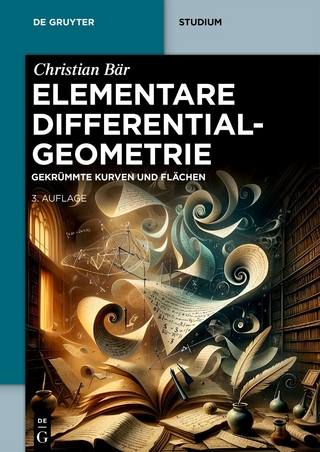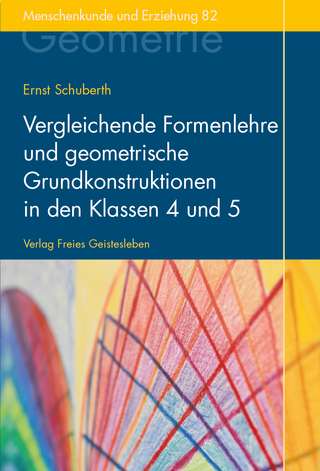
Geometry at the Quantum Scale
Springer International Publishing (Verlag)
978-3-031-61196-4 (ISBN)
- Noch nicht erschienen - erscheint am 08.09.2024
- Versandkostenfrei innerhalb Deutschlands
- Auch auf Rechnung
- Verfügbarkeit in der Filiale vor Ort prüfen
- Artikel merken
This book presents a single geometric language for the fundamental physics that has been discovered from the beginning of the twentieth century to the present day. The first two chapters give a brief summary of the four known fundamental forces, namely the three known gauge forces (the electromagnetic and the two nuclear forces) and the gravitational force. These chapters also summarize the main experimental results from high energy physics, including the implications of the existence of the Higgs particle discovered at the LHC, and the implications of recent astronomical observations. The subsequent chapters include quantum gravity based on the consequences of the't Hooft-Veltman renormalization theorem for gauge fields and the non-renormalization of Einstein's gravitational field of General Relativity.
The main focus of the book is to show that the three gauge forces are defined in the quantum domain, while Einstein's gravitation remains an essentially classical interaction. However, the main implication of Einstein's reasoning is built into the Einstein-Hilbert action principle, which is independent of the source of gravitation. As such, the Einstein-Hilbert principle by itself does not depend on any specific source, leading to a gravitational field that is far more general than that defined by General Relativity, while retaining all its geometrical characteristics. This makes a key difference in the sense that all four fundamental interactions may now be defined in the same quantum domain. Einstein's classical theory of General Relativity becomes a particular case of the quantum gravitational field defined by the Einstein-Hilbert action.
At the quantum scale, the direct sum of the resulting four geometries produces an 11-dimensional Riemannian geometry whose curvature defines a new quantum cosmology without hierarchies, so that all fundamental interactions contribute effectively to the evolution of the universe, a result that is of interest to high energy physicists, cosmologists, mathematicians, philosophers and all those who seek a plausible explanation for the physical world.
Marcos Duarte Maia was born in the state of North Rio Grande, Brazil. He studied engineering at the State University of Goiás (Brazil), and obtained a BSc degree in Physics in 1966 at the University of Brasilia under supervision of Jayme Tiomno. He moved to London in 1967 to work with Hermann Bondi on gravitational waves as a research student at King's College of the University of London. Soon after, Bondi moved to the ESRO program in Vienna, and his supervision was transferred to Professor Clive Kilmister. In 1971 he defended a thesis on the subject of Eddington's Fundamental Theory. After his return to Brazil, he was hired by the Department of Mathematics of the University of Brasilia in 1971, where he stayed for the next 20 years, before moving to the Physics Institute of the same university. In 1975, he was a Senior Visitor at the DAMTP, University of Cambridge, in Hawking's group on mini black holes. In the period of 1982 to 1984, he was a an Associate Member visitor to the ICTP (Trieste, Italy) working on the Kaluza-Klein unification program. In 1985 he was a visiting scientist at the University of Washington at Seattle. At the end of his program in Seattle, he moved to the Institute of Theoretical Physics at Santa Barbara, California, and as a research visitor to the Stanford Linear Accelerator (SLAC). In 1993, he was a Visiting Scientist at the NASA-Fermilab Astrophysical Center near Chicago. His present position is as a Retired Senior Research Associate at the Institute of Physics of the University of Brasilia.
Edmundo Marinho do Monte has a bachelor's degree in mathematics from the Federal University of Paraíba (UFPB), Brazil, a master's degree in atmospheric sciences from UFPB, Brazil, and a PhD in mathematics from the University of Brasília (UnB), Brazil, with a thesis in general relativity. He was a Postdoctoral researcher in relativity at the Department of Geometry and Topology, Granada University (UGR, Spain) and has held visiting professor positions at the International Center for Theoretical Physics (ICTP), Italy, and UGR, Spain. He entered UFPB through competition as a Professor in the Department of Mathematics at UFPB. He is currently Full Professor at the Department of Physics at UFPB, João Pessoa, Brazil. He has experience in the area of physics and mathematics, with an emphasis on fundamental geometric problems in spacetime immersions, working mainly on the following topics: immersions of pseudo-Riemannian manifolds, space-time immersions, geometry and topology of space-times, special and general relativity, cosmology and gravitation.
Chapter 1 A Brief Review on Gauge Forces.- Chapter 2 Gravitation and Cosmology.- Chapter 3 Quantum Gravity.- Chapter 4 Renormalizable Einstein's Gravitation.- Chapter 5 The Renormalizable Einstein's Gravitation.- Chapter 6 Symmetry Mixing.- Chapter 7 The Equations of the Standard Model.- Chapter 8 The Relativistic Poincaré Conjecture.- Chapter 9 The Higgs Roulette.- Chapter 10 Quantum Black Holes at the LHC.
| Erscheint lt. Verlag | 8.9.2024 |
|---|---|
| Zusatzinfo | X, 160 p. 20 illus., 10 illus. in color. |
| Verlagsort | Cham |
| Sprache | englisch |
| Maße | 155 x 235 mm |
| Themenwelt | Mathematik / Informatik ► Mathematik ► Geometrie / Topologie |
| Naturwissenschaften ► Physik / Astronomie ► Hochenergiephysik / Teilchenphysik | |
| Naturwissenschaften ► Physik / Astronomie ► Theoretische Physik | |
| Schlagworte | affine Geometry • Frobenius theorem in differential topology • Gell-Mann quaternion basis • Horava-Lifschitz gravity • Nash theorem for space-time • Quadrupole waves • Quantum geometry • Quantum Gravity • Theory of everything |
| ISBN-10 | 3-031-61196-9 / 3031611969 |
| ISBN-13 | 978-3-031-61196-4 / 9783031611964 |
| Zustand | Neuware |
| Haben Sie eine Frage zum Produkt? |
aus dem Bereich


